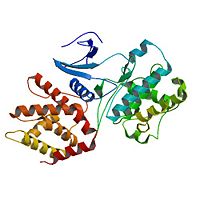Sandbox 210
From Proteopedia
| Line 17: | Line 17: | ||
===Sequence similarities=== | ===Sequence similarities=== | ||
| - | The <scene name= | + | The <scene name='Sandbox_210/1h4l_chainsab/2'>chains A and B</scene> of the CDK5-p25 complex share homologuous sequences with the cell division protein kinase 5 and the chains D and E with the cyclin-dependent kinase 5 activator (p35). |
The subunit of the CDK5 shares also a very similar three-dimensional (3D) structure with CDK2. | The subunit of the CDK5 shares also a very similar three-dimensional (3D) structure with CDK2. | ||
Revision as of 18:54, 22 December 2011
Contents |
CDK5-p25 complex
CDK means Cyclin Dependent Kinase. The cyclin-dependent kinases (CDKs) are a large family of serine–threonine kinases which control the eukaryotic cell cycle, when they are activated by the cyclin regulatory subunit. These kinases phosphorylate a very large number of protein in order to inactivate or activate them.[1] Cyclin dependent kinase 5 (CDK5) is a unique member of CDK family members that is not activated by a cyclin. Instead it is activated by a kinase, p35 also named Cyclin-dependent kinase 5 activator. Unlike other CDKs, it plays a major role in cell communication, cell morphology and motility.
CDK5 could form a complex with p25, an other protein.
Structure
Sequence similarities
The of the CDK5-p25 complex share homologuous sequences with the cell division protein kinase 5 and the chains D and E with the cyclin-dependent kinase 5 activator (p35).
The subunit of the CDK5 shares also a very similar three-dimensional (3D) structure with CDK2.
Applications of CDK5-p25 complex
Biology
CDK5-p25 complex Control
References
- ↑ Zhang B, Su ZC, Tay TE, Tan VB. Mechanism of CDK5 activation revealed by steered molecular dynamics simulations and energy calculations. J Mol Model. 2010 Jun;16(6):1159-68. Epub 2009 Dec 15. PMID:20013135 doi:10.1007/s00894-009-0629-4


